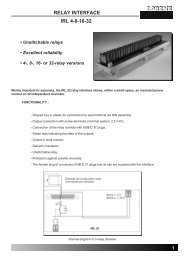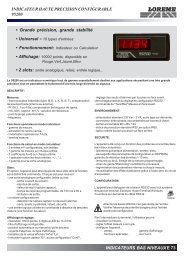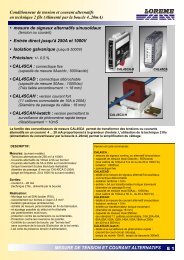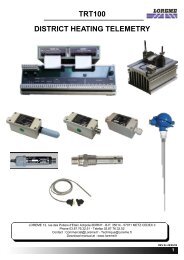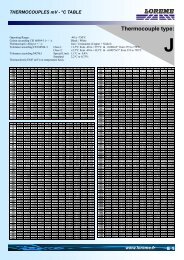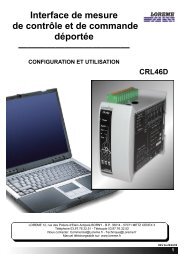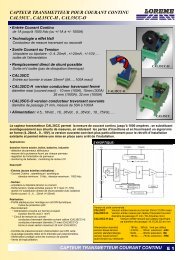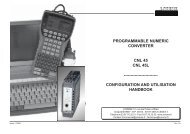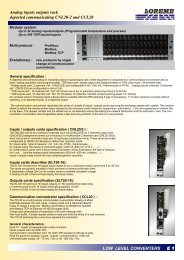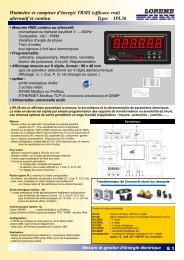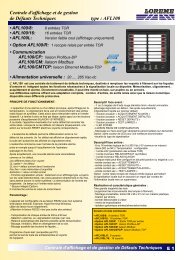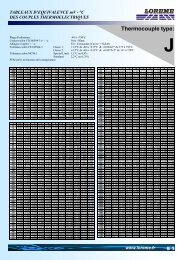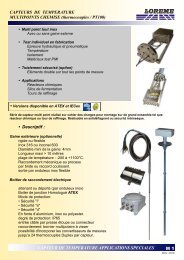manual Ipl244-144L rev2.0f eng.pdf - LOREME
manual Ipl244-144L rev2.0f eng.pdf - LOREME
manual Ipl244-144L rev2.0f eng.pdf - LOREME
You also want an ePaper? Increase the reach of your titles
YUMPU automatically turns print PDFs into web optimized ePapers that Google loves.
SOMMAIRERS485 Communication Modbus1) Internal structure:1.1) Presentation:The device is divided in two cells. Each cell has a specific functionwhile keeping a continuous exchange of pieces of information withthe second cell.The first cell is in charge of the measure, analysis and conversionfunction.The second cell is in charge of the communication function.The information exchange is continuous and automatic.1.2) Measure function:The measure cell runs the acquisition of the different signals and calculates all the values with regards to the configurationof the device.It also runs all the output functions (analogical, alarm, meter, RS 232). All measured or calculated parameters are storedin the system memory and are constantly refreshed.1.3) Communication function:The communication cell runs the RS485 communication interface in the MODBUS/JBUS protocol. It analyzes the requestsof the main station and answers if the device is addessed. It draws all these data from the system memory thatcan be continuously accessed.1.4) System memory:Each cell can continuously access the system memory. The latter has a dual access, which allows a reading/writing ofthe data whitout any possible internal conflicts.2) Communication:The type of protocol used is: MODBUS/JBUS in RTU mode. The communication has neither header nor delimitator offrame. The detection of the start of frame is made by a silence whose time is at least equal to the transmission of 3.5bytes. It implies that a frame received can be processed only after a time equal to the silence given before. The time ofthis silence is directly linked to the speed of transmission of the system:Ex: Speed 9600 bauds - no parity (10 bits/byte)Silence = (3.5 x 10) / 9600 = 3.64 msThe device starts to process the frame 3.64 ms after receiving the last byte.Note: The time separating two bytes from a same frame must be inferior to a silence. If the user does not comply withthis condition,the second byte will be considered as the first one of a new frame.The interval of time separating the end of reception of the last byte of the question frame and the end of emission of thefirst byte of the answer frame (detection of frame of the main station) constitutes the answer time of the device.This answer time Trep includes:- the silence (time of 3.5 bytes) Ts,- the processing of the frame Tt,- the emission of the first byte Te1.The time beyond which the device does not answer is called "TIME OUT". It depends on the transmission parameters(speed, format) and the type of the function asked (reading, writing). This time must be defined by the user and must besuperior to the answer time of the device.A complete communication cycle includes :- the question frame transmission Tq- the device answer time Trep- the answer frame transmission TrThree reasons might cause aTIME OUT:- wrong transmission data at the question frame time- wrong configuration of the TIME OUT on the main station- dependent station out-of-order.E 16<strong>LOREME</strong> 12, rue des Potiers d'Etain - 57071 Metz 03.87.76.32.51 - Fax 03.87.76.32.52 - Email: Commercial@Loreme.fr - Techni-



